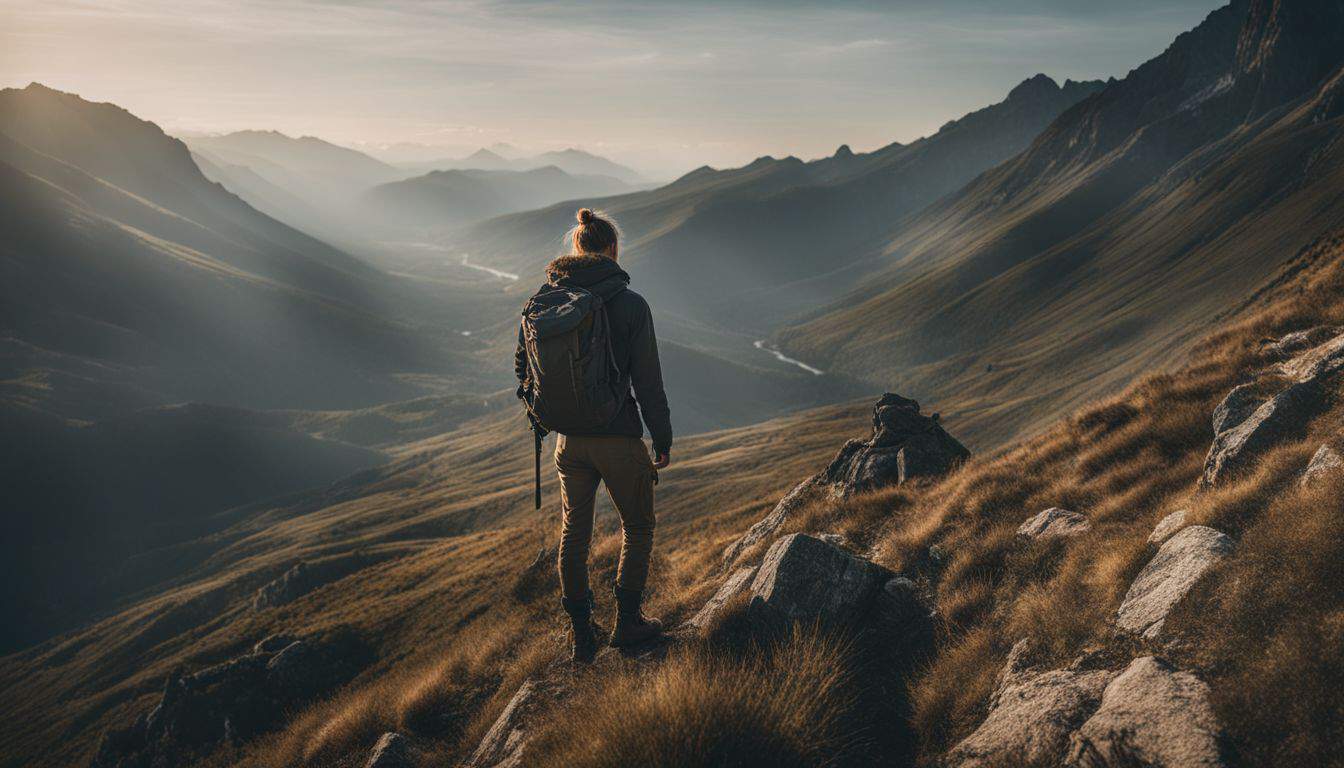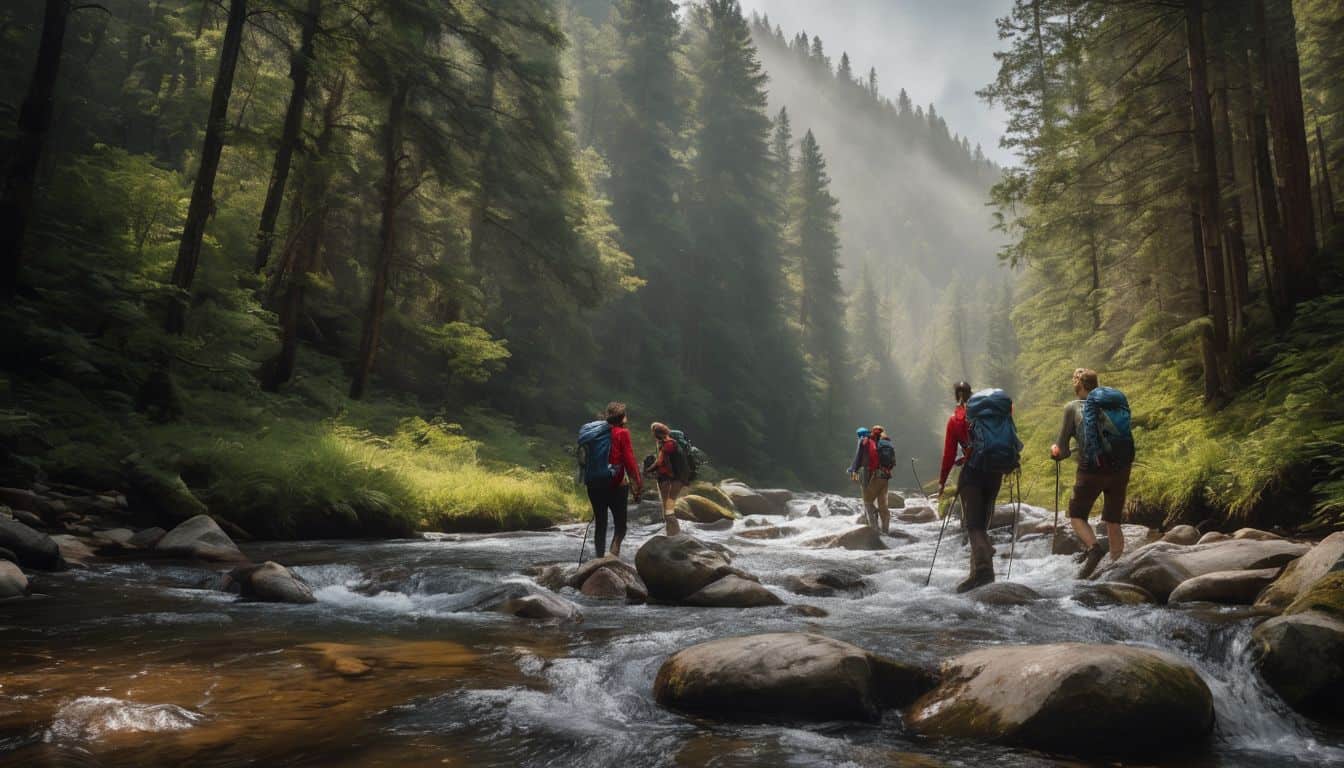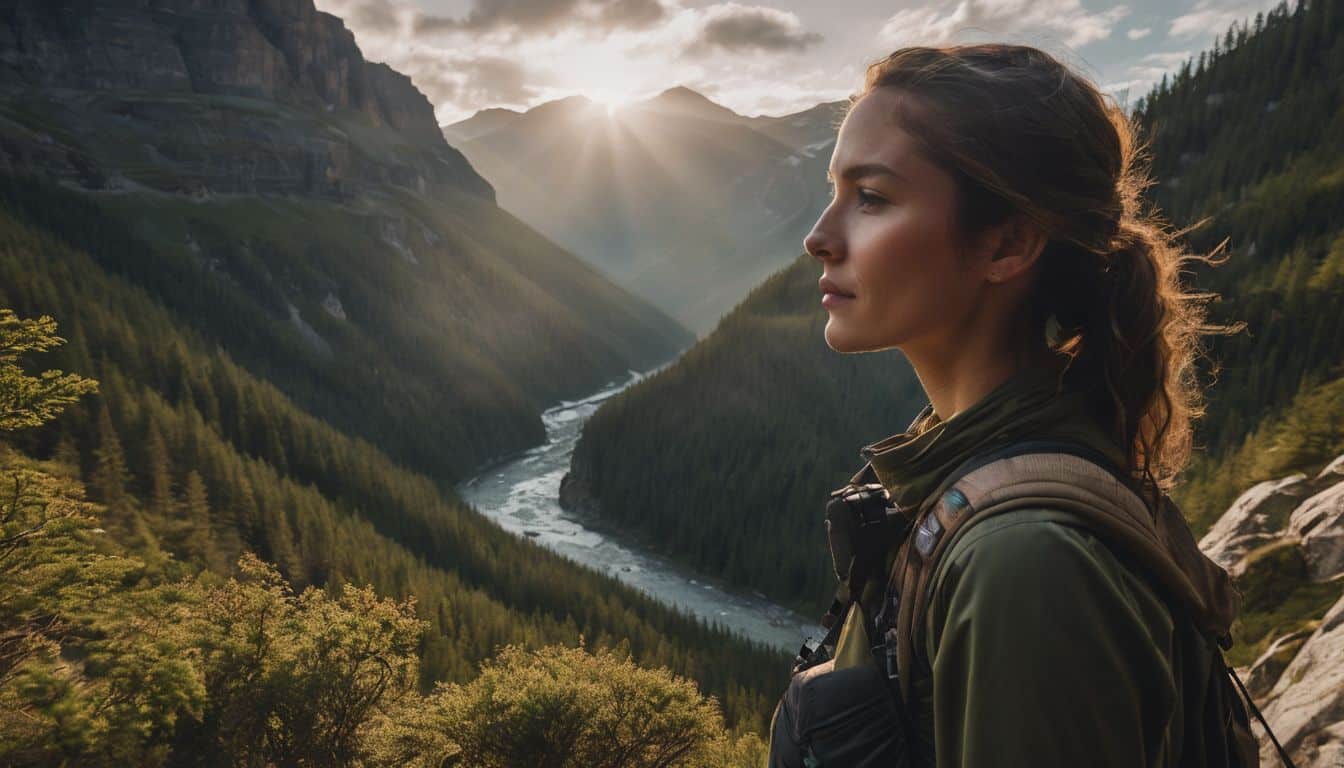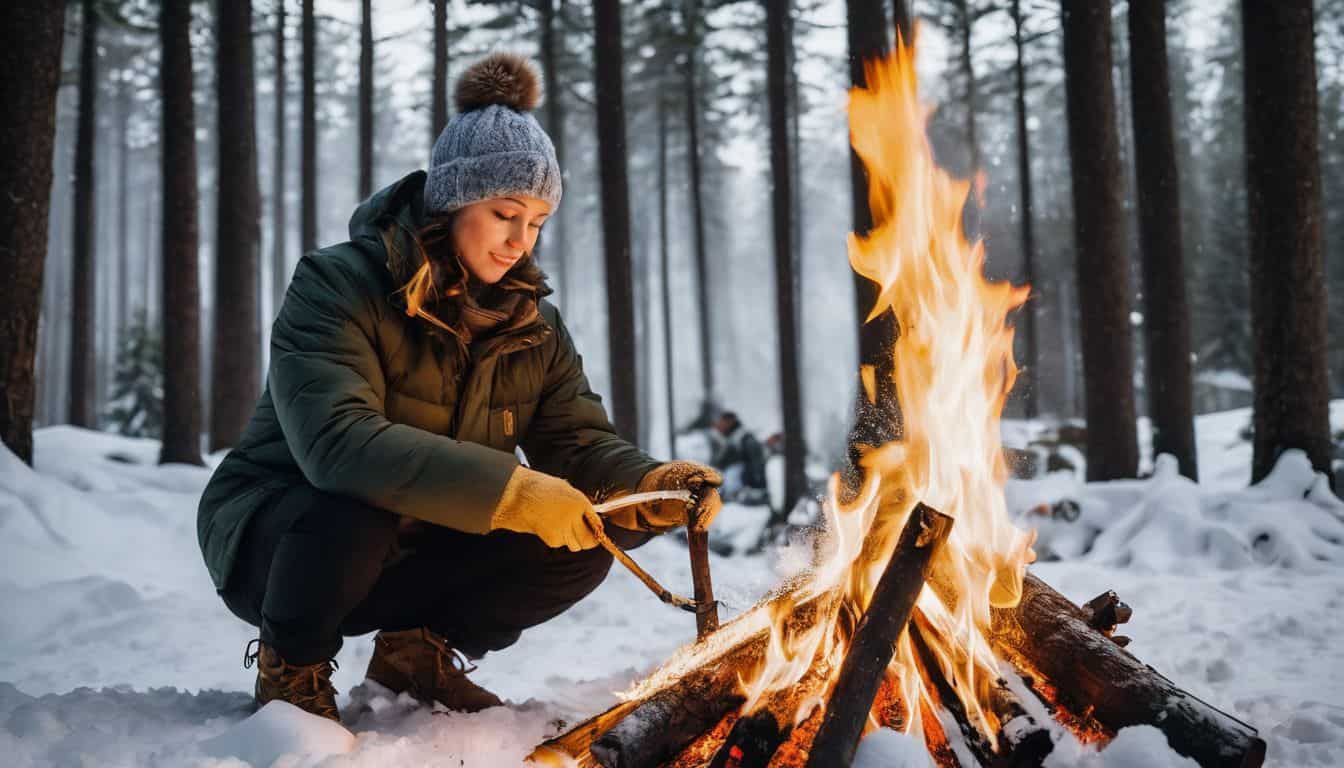Picture yourself venturing into the untamed wilderness and unexpectedly losing your way. It’s a daunting experience that hits close to home, as I’ve traversed those unsettling paths before.
This chilling encounter ignited my curiosity about the crucial topic of survival priorities. This blog will serve as your compass, guiding you through understanding and mastering the top seven survival priorities in line with the rule of threes.
With this knowledge under your belt, you’ll be prepared to prevail over any survival situation that comes your way. So let’s embark on this journey – it’s time for us to face our fears together!
Key Takeaways
- Understanding survival priorities is crucial in high – stress situations. It goes beyond basic skills and involves making logical decisions to stay safe.
- The rule of threes guides survival priorities: positive attitude, first aid, shelter, water, warmth, signals, and food.
- Having a positive attitude helps maintain mental resilience and problem – solving abilities in survival situations.
- First aid knowledge is essential for treating injuries and illnesses in the wild. Carrying a well – stocked first aid kit can be lifesaving.
- Shelter provides protection from extreme weather conditions and helps regulate body temperature. It should be prioritized after a positive attitude and first aid.
- Water is one of the three essentials for survival. Finding and purifying water is vital for staying hydrated in a survival situation.
- Warmth is important for maintaining body temperature. Knowing how to build fires and insulate yourself can help you stay comfortable in harsh conditions.
- Signaling for help increases your chances of being rescued. Smoke signals or using signal devices like mirrors or flares are effective techniques.
- Food falls lower on the list of survival priorities but becomes critical for long – term survival. Rationing limited supplies until rescue or finding additional resources is important.
- Understanding survival priorities means making smart choices during high – stress situations to increase your chances of staying safe.
- The rule of threes outlines the top seven survival priorities: positive attitude, first aid, shelter, water, warmth, signals, and food.
- A positive attitude helps maintain mental resilience while first aid knowledge can save lives by treating injuries.
- Shelter offers protection from extreme weather conditions while finding clean water ensures hydration.
- Warmth maintains body temperature through fire – building techniques while signaling attracts attention for potential rescue.
- Food becomes more crucial over time but initially takes priority after ensuring other immediate needs are met
Understanding Survival Priorities: An Overview
As someone with a passion for survival strategies, I feel compelled to stress the significance of understanding survival priorities. This goes beyond knowing how to start a fire or construct makeshift shelter.
At its core, mastering the art of survival comes down to making knowledgeable and logical decisions in high-stress scenarios where your life could be hanging in balance.
Survival doesn’t just test your physical limits; it also demands mental strength and decision-making abilities—two key factors that can determine how well you manage crisis situations.
For instance, when thrown into an unexpected emergency situation, many folks tend to react instinctively out of shock and panic rather than calmly evaluating their options based on critical survival priorities like securing water supply, finding food or building shelter.
This form of tunnel vision only fuels further panic and undermines self-sufficiency—making resource management an even tougher battle.
Being clear about what should be done first (and why) is vital—it helps keep your mind focused and maintain control over the situation as chaos unfolds around you. It becomes particularly crucial if you adhere to the ‘Rule Of Threes’ – putting emphasis on prioritizing shelter above water supplies, followed by food necessities – these guidelines can perhaps be lifesaving, safeguarding health matters amidst harsh realities we’re often more used seeing through screen-time from our comfy couches! So bear this in mind: Your survival isn’t always about racing against time — sometimes it’s purely about strategically planning ahead..a poignant insight indeed offered up by these invaluable survival priorities list!
The Rule of Threes for Survival Priorities

In survival situations, understanding the rule of threes is essential for prioritizing your needs: positive attitude, first aid, shelter, water, warmth, signals, and food.
Positive Attitude
Having a positive attitude is key in any survival situation. The Rule of Threes for Survival Priorities talks about the power of keeping your spirits high. It’s not just about what you do with your hands and feet.
Your brain plays a big part too! Fear can make you freeze up or make bad choices. But if you keep calm, stand tall, and think happy thoughts, it can help a lot.
You may face tough moments that will test your mental strength. But don’t let this scare you! This is where having an upbeat mindset steps in to save the day. It helps to build emotional control so that stress won’t get to you easily.
Plus, it builds up your coping skills for when things get extra hard out there in the wilds.
First Aid
You need to know basic first aid to stay alive. This is a must-have survival skill. It can help you treat injuries and illnesses when there are no doctors around. Even a small cut can become bad without treatment in the wild! So, carry a first aid kit with all needed supplies.
Learn how to use it too before an emergency comes up. Your life may depend on your quick thinking and action! Practice these lifesaving techniques often; it’s one part of the Rule of Threes for Survival Priorities you don’t want to skip.
Shelter
Shelter is one of the most important things to prioritize in survival situations. It provides protection from extreme weather conditions and helps regulate our body temperature. Without shelter, we can only survive for about 3 hours in harsh environments.
It’s crucial to find or create a shelter using natural materials like branches and leaves, or by using survival tools such as tents or emergency blankets. Having adequate shelter not only keeps us safe physically but also provides psychological comfort and a sense of security during challenging times.
Water
Water is extremely important for survival. In fact, it’s one of the three essential things we need to stay alive. Without water, our bodies can become dehydrated and we won’t be able to function properly.
The rule of threes tells us that a person can only survive about three days without water. That’s not very long! So, when you’re in a survival situation, finding and purifying water should be one of your top priorities.
Look for natural sources like streams or lakes, but be sure to purify the water before drinking it to avoid getting sick from any contaminants. And remember, staying hydrated is crucial for your overall well-being in a survival scenario.
Warmth
In survival situations, warmth is absolutely vital. It helps us maintain our body temperature and stay comfortable in harsh conditions. One of the key ways to generate heat is through fire.
Fire not only provides warmth but can also be used for cooking food, purifying water, and signaling for help. It’s important to know how to build a fire using different techniques, as well as gather and prepare firewood.
Another aspect to consider when it comes to warmth is heat loss and gain. Understanding how heat is lost from our bodies and finding ways to insulate ourselves can make a huge difference in staying warm.
Signals
When you find yourself in a survival situation, signaling for help is crucial to getting rescued. It’s important to attract attention and let others know that you need assistance. There are different techniques you can use to signal for help, such as creating smoke signals or using a whistle.
Carrying signal devices like a mirror or a flare can also be helpful. Remember, the Rule of Threes reminds us that while signaling is important, it should be prioritized after ensuring we have air supply, shelter, and drinking water for our life preservation.
By understanding these priorities and knowing how to effectively signal for help, we can maximize our chances of being rescued.
Food
Food is an important consideration in survival situations, but it’s not the most immediate priority. According to the Rule of Threes, which outlines our survival needs, food falls lower on the list.
While we can survive for weeks without eating, other priorities like air, shelter, and water should take precedence initially. Rationing the limited food supplies you have becomes crucial until rescue or finding additional resources.
However, as time goes on, food becomes more critical for long-term survival and maintaining your physical strength and mental sharpness. So even though it’s not at the top of the list right away, finding and procuring nourishment is still vital in wilderness survival scenarios.
Importance of a Positive Attitude in Survival Situations
A positive attitude is crucial in survival situations as it helps to maintain mental resilience, enhance problem-solving abilities, and continuously fuel hope and motivation.
Mental resilience
Developing mental resilience is crucial in survival situations. It helps us keep a positive attitude, cope with fear and uncertainty, and adapt to challenging circumstances. With a resilient mindset, we can overcome setbacks and maintain hope and motivation when facing difficulties.
Resilience means being emotionally strong and having the ability to bounce back from adversity. By training our minds and learning psychological survival techniques, we can enhance our mental strength and increase our chances of surviving in any situation.
Having a positive attitude is not about ignoring the challenges or pretending everything is fine. Instead, it’s about acknowledging the reality while choosing to focus on solutions rather than dwelling on problems.
It involves managing fear effectively so that it doesn’t paralyze us or lead to panic. By staying calm under pressure, we can think more clearly and make better decisions for our survival.
One key aspect of mental resilience is developing coping skills to deal with stress and trauma. This includes understanding how our emotions affect us physically and mentally, as well as finding healthy ways to process those emotions.
Building resilience also involves practicing self-care by taking care of our basic needs like rest, nutrition, hydration, and exercise.
Problem-solving abilities
Problem-solving abilities are incredibly important in survival situations. When faced with challenges and obstacles, having strong problem-solving skills can make all the difference in finding solutions and keeping yourself safe.
Additionally, problem-solving abilities are associated with understanding survival priorities and effectively addressing them. Being able to think critically, make decisions quickly, adapt to changing circumstances, and find creative solutions is crucial for survival.
Remember, problem-solving abilities are not only valuable in wilderness scenarios but also in various aspects of life. So, by continuously practicing and honing your skills, you can become more resourceful, resilient, and strategic in any situation you may face.
Maintaining hope and motivation
In survival situations, maintaining hope and motivation is vital for your mental strength. Staying positive can help you overcome challenges and keep going. It’s important to have an optimistic mindset and believe in your ability to survive.
Positive self-talk and reminding yourself of the goal of survival can boost your morale. Remember, a resilient attitude and emotional strength will help you stay motivated throughout the ordeal.
So, keep pushing forward with a positive outlook because it can make all the difference in surviving. Stay strong!
First Aid as a Critical Survival Priority
In a survival situation, first aid is essential for treating injuries and illnesses in the wild. Basic first aid skills can be lifesaving, allowing you to stabilize someone until professional medical help arrives.
Don’t forget to carry a well-stocked first aid kit with you at all times for quick and efficient treatment of any emergencies that may arise.
Basic first aid skills
Administering first aid can make a life-saving difference in emergencies. It’s important to know some basic first aid skills, such as cleaning and dressing wounds, performing hands-only CPR, and using the Heimlich maneuver. These skills are easy to learn and can be recalled quickly during emergencies. They can also help in securing food and providing medical aid during outdoor survival situations. Remember that having knowledge of basic first aid could mean the difference between life and death in critical situations.
Treating injuries and illnesses in the wild
Treating injuries and illnesses in the wild is incredibly important for survival. When you’re out in the wilderness, accidents can happen, and it’s crucial to know how to respond. By having basic first aid skills and a well-stocked first aid kit, you can prevent minor injuries from becoming major ones.
Having a positive attitude is also key because it helps with mental resilience, problem-solving abilities, and maintaining hope and motivation during tough situations. In the wild, you may encounter various injuries and illnesses like bone fractures, heat exhaustion, hypothermia, lightning-related injuries, or allergic reactions.
Knowing how to address these issues can greatly increase your chances of survival. Remember that treating injuries and illness should be one of your highest priorities when faced with a survival situation.
Importance of a first aid kit
Having a first aid kit is absolutely crucial in any survival situation. A first aid kit contains essential medical supplies that can help reduce the risk of minor injuries from becoming worse.
In emergency situations, immediate assistance is vital in addressing critical needs and increasing the chances of survival. With basic first aid training and the right supplies on hand, you’ll be able to provide initial care for wounds, burns, sprains, and other common injuries.
So don’t forget to include a well-stocked first aid kit in your outdoor gear or wilderness survival pack – it could make all the difference when it comes to keeping yourself and others safe during an emergency.

Shelter: Protecting Yourself from the Elements
In extreme weather conditions, having shelter is crucial for survival. Learn how to build makeshift shelters and gather essential supplies to protect yourself from the elements. Read more about mastering survival tactics in any scenario.
Importance of shelter in extreme weather conditions
Shelter is incredibly important in extreme weather conditions. When facing strong winds, heavy precipitation, and cold temperatures, finding shelter can mean the difference between survival and danger.
In wet and cold environments, taking cover from the elements is crucial for staying safe and protected. Shelter provides a barrier against the harsh forces of nature like wind, rain, or snow.
Along with a proper shelter, having a fire can also be essential in colder environments to keep warm. Building a suitable shelter and insulating it properly are key outdoor survival tips that will help you stay out of harm’s way.
Building makeshift shelters
Building a shelter is one of the most important skills in survival situations. It can protect you from harsh weather conditions and provide a safe place to rest. Here are some key points to consider when building makeshift shelters:
- Use natural materials: Look for branches, leaves, and other natural materials to construct your shelter. They can provide insulation and protection from the elements.
- Find a suitable location: Choose a spot that is away from potential dangers like falling trees or flooding areas. Look for high ground or sturdy trees to anchor your shelter.
- Create a frame: Start by creating a solid frame using sturdy branches or logs. This will serve as the foundation for your shelter.
- Layer materials: Layer leaves, grass, and smaller branches on top of the frame to create a thick barrier against wind and rain.
- Insulation: Add extra layers of leaves or moss inside your shelter for added insulation. This will help retain body heat during cold nights.
- Test stability: Before settling in, make sure your shelter is stable and secure. Ensure that it can withstand strong winds or heavy rain.
Essential shelter supplies
When it comes to survival, having the right supplies for shelter is essential. Here are some important shelter supplies you should have:
- Tarps or emergency blankets: These lightweight and compact items can provide protection from rain, wind, and cold.
- Rope or paracord: This versatile tool can be used to secure your shelter and create a sturdy structure.
- Sleeping bag or thermal blanket: These items will help keep you warm when sleeping in your shelter.
- Groundsheet or mat: Placing a groundsheet or mat under your shelter will provide insulation and keep dampness away.
- Tent stakes or pegs: These will help secure your shelter to the ground, preventing it from collapsing in strong winds.
Finding and Purifying Water in Survival Scenarios
In survival scenarios, it is crucial to know how to find and purify water.
Sources of water in the wilderness
Finding clean drinking water is one of the most important things in a survival situation. Here are some sources of water you can find in the wilderness:
- Rivers and Streams: Look for flowing water, as it’s less likely to be contaminated. Use a water filter or purifier to make it safe.
- Lakes and Ponds: These can be good sources of water, but remember to still purify it before drinking. Boiling or using water purification tablets can help.
- Rainwater: Collecting rainwater is a great way to get safe drinking water. Use containers or tarps to catch rainwater during a downpour.
- Natural Springs: If you come across a natural spring, it may provide clean and pure drinking water. Be cautious and use your judgment to ensure its safety.
Water purification methods
In survival situations, having access to safe drinking water is crucial. Here are some effective water purification methods you should know:
- Boiling: Boiling water is one of the simplest and most effective ways to make it safe for drinking. Heat the water until it reaches a rolling boil, and let it boil for at least one minute to kill any harmful viruses and pathogens.
- Chemical Treatment: Using chemical tablets or drops can also purify water. These chemicals, such as iodine or chlorine, kill bacteria and viruses present in the water. Follow the instructions provided with the treatment product for proper usage.
- Filtration: Filtration systems can remove impurities from water by passing it through a fine filter that traps bacteria, parasites, and sediment. There are different types of portable filters available, including straw filters, pump filters, and gravity filters.
- Solar Disinfection: This method utilizes sunlight to disinfect water. Fill a clear bottle with untreated water and leave it in direct sunlight for at least six hours (or two days if it’s cloudy). The heat and ultraviolet radiation from the sun will kill many harmful microorganisms.
- Distillation: Although challenging in a survival situation, distillation can be used for desalination — removing salt from seawater. It involves evaporating the liquid by heating it and collecting the condensed vapor, which is free from salt or other contaminants.
- “Waterborne diseases” – Understanding Survival Priorities
- “Water treatment” – Understanding Survival Priorities
- “Drinking Water Safety” – Understanding Survival Priorities
Carrying water supplies
Finding and purifying water is crucial in survival scenarios. When out in the wilderness, it’s important to have a strategy for collecting, filtering, and storing water. I always make sure to carry containers or bottles that can hold a sufficient amount of water.
This allows me to collect water from various sources like rivers, streams, or even rainfall. To ensure the water is safe to drink, I use purification methods such as boiling it over a fire or using purification tablets.
I also have a cloth or filtration system on hand to remove any impurities. By being prepared with the right equipment and knowledge, I can stay hydrated and maintain my well-being in challenging situations.
Maintaining Warmth in Harsh Conditions
To maintain warmth in harsh conditions, proper clothing and layering are essential. Fire-making techniques and insulating shelter also play a crucial role in preserving body heat and preventing hypothermia.
Importance of proper clothing and layering
Proper clothing and layering are essential for staying warm in harsh conditions. When it’s cold outside, wearing multiple thin layers is more effective than a single thick layer because it traps warm air between the layers.
Additionally, layering helps regulate your body temperature and keeps you both warm and dry from the inside and outside. To do this, you need a base layer made of a non-absorbent material to wick away water and keep your skin dry.
Then, add middle layers for insulation and warmth, followed by an outer shell layer that is weatherproof and wind-resistant. Remember, understanding how to properly layer your clothing is crucial for staying comfortable outdoors in cold weather conditions.
Fire-making techniques
Starting a fire is a crucial skill for survival in tough conditions. Here are some important fire-making techniques to keep in mind:
- Use a fire starter: A fire starter, such as waterproof matches or a lighter, can quickly ignite a flame even in wet conditions.
- Gather tinder: Find dry and flammable materials like dry leaves, bark, or small twigs to serve as the initial fuel for your fire.
- Build a teepee structure: Arrange your kindling in a teepee shape, leaving enough space in the center for the flame to catch on to the larger pieces of wood.
- Blow gently: Once you have ignited the tinder, blow gently on the embers to help them grow into flames and spread throughout the fire.
- Add bigger logs: Gradually add larger logs to sustain the fire and provide lasting warmth.
- Maintain airflow: Ensure there is sufficient airflow by arranging logs with enough space between them. This helps keep the fire burning steadily.
- Extinguish safely: When you’re done with the fire, make sure it is fully extinguished by pouring water over it and stirring the ashes until they are cool to touch.
Insulating shelter
Insulating your shelter is really important in harsh conditions. It helps to trap and hold heat, so you can stay warm. You want to use materials that are light and fluffy with lots of air space between them.
These types of materials are great at keeping the cold out and the heat in. Insulation also protects you from extreme weather like wind, rain, and snow. It’s a key factor in maintaining warmth when it’s freezing outside.
So make sure your shelter is properly insulated for winter survival!
Signaling for Help
Signaling for help is a critical survival priority that can make all the difference in getting rescued. Learn about different signaling techniques and essential signal devices to increase your chances of being found quickly.
Read more on understanding survival priorities to dominate in any scenario.
Importance of attracting attention
In a survival situation, attracting attention is vital. It helps rescuers locate and assist you. Signaling for help can be the difference between being found or staying lost. To enhance visibility, you can use different methods such as creating three fires in a triangle shape or using distress signals that are widely recognized.
Timing is crucial, so choose the best moment to signal when wind won’t affect it. By attracting attention, you increase your chances of being rescued and bringing an end to your wilderness adventure.
Remember, the focus should always be on notifying rescuers and enhancing your visibility.
Different signaling techniques
When it comes to survival, signaling for help is crucial. Here are different techniques you can use:
- Smoke signals: Create a fire and produce smoke by adding green vegetation or damp materials.
- Whistles: Carry a whistle and blow it in short bursts of three to attract attention.
- Mirror signals: Use a reflective surface, such as a mirror or shiny metal, to reflect sunlight towards potential rescuers.
- Flares: Keep flares in your survival kit and use them to create bright flashes of light in the sky.
- SOS signal: Use international distress signals like Morse code (three short, three long, three short) to communicate your need for help.
- Signal fires: Build a fire in an open area with easily combustible materials like branches or dry leaves to create visible flames and smoke.
Carrying signal devices
Carrying signal devices is essential for survival in the wilderness. Here are some important items to have:
- Personal Locator Beacons (PLBs): These devices can send distress signals and your location to rescue authorities, increasing your chances of being found quickly.
- Communication devices: Radios or satellite phones can help you communicate with rescuers or other nearby individuals in case of an emergency.
- Flares: These bright, colorful lights can be seen from a distance and are effective for signaling for help, especially during nighttime or low visibility conditions.
- Whistles: A loud whistle can attract attention and alert others to your presence. Keep one handy on your person or attached to your backpack.
- Signal mirror: Mirrors with a reflective surface can be used to flash sunlight in a specific direction, catching the attention of passing aircraft or search teams.
The Role of Food in Survival
Finding and foraging for food is of utmost importance in survival situations, as it provides the necessary sustenance and energy needed to endure challenging circumstances.
Importance of finding and foraging for food
Finding and foraging for food is essential when it comes to survival in the wild. It is one of our most basic needs, and without sufficient nourishment, our bodies cannot function properly.
In a survival situation, knowing how to find edible plants, insects, and other food sources can make a significant difference in your ability to sustain yourself.
When you’re out in the wilderness, it’s important to be aware of the various food sources available around you. Some plants and insects are safe to eat and can provide valuable nutrients.
For example, certain berries or edible greens can offer vitamins and antioxidants that are beneficial for our health. Understanding which ones are safe to consume and preparing them correctly is crucial.
In addition to plant-based foods, learning hunting techniques can also increase your chances of finding sustenance in survival scenarios. Trapping small game or fishing using improvised tools can help meet your nutritional needs as well.
Edible plants and insects
Edible plants and insects are valuable sources of food in survival situations. They can provide essential nutrients and sustain you when other food sources are scarce. Here are some key points to consider:
- Diversify your diet: Incorporating a variety of edible plants and insects into your meals can ensure a balanced intake of vitamins, minerals, and proteins.
- Learn about local vegetation: Understanding the types of wild plants in your area is crucial for foraging safely. Take the time to educate yourself on which plants are safe to eat and how to identify them.
- Consider insects as protein sources: Edible insects, such as crickets, mealworms, and grasshoppers, are high in protein and can be a sustainable food option. The Food and Agriculture Organization recognizes their importance for food security.
- Practice proper preparation: Some edible plants may require cooking or processing to remove toxins or enhance flavor. Research how best to prepare different plant species before consuming them.
- Respect the environment: When foraging for edibles, remember not to over-harvest or damage natural habitats. Leave enough behind so that plants can continue to reproduce and support wildlife.
- Be cautious with unfamiliar foods: If you come across a plant or insect that you’re unsure about, it’s better to err on the side of caution and avoid eating it. Mistaking toxic species for edible ones can have serious consequences.
- Develop wilderness survival skills: Alongside knowledge of edible plants and insects, it’s important to learn other survival skills like navigation, shelter-building, and fire-making. These skills will increase your chances of thriving in the wild.
- Food Insecurity Information Network (FIIN). (2013). Edible insects – Future prospects for food and feed security. Rome, Italy: FAO.
- United States Department of Agriculture (USDA). (n.d.). Wild Edible Plants. Retrieved from https: //www.fs.fed.us/wildflowers/ethnobotany/edible/index.shtml
Trapping and hunting techniques
Trapping and hunting techniques are important skills to learn in survival situations. Here are some effective methods:
- Setting traps: Traps can help catch wild game while you focus on other survival tasks. Learn how to set snares, deadfalls, and pitfall traps.
- Understanding animal behavior: Knowing how animals move, what they eat, and their size can increase your chances of successful trapping or hunting. Study their tracks, droppings, and feeding patterns.
- Fishing techniques: Fishing is another way to secure food in the wild. Learn different fishing methods like using nets, lines with hooks, or making fish traps.
- Camouflage and stalking: Blend into your surroundings by wearing clothes that match the environment. Practice stalking techniques to get closer to animals without scaring them away.
- Using calls and decoys: Mimicking animal sounds can attract them towards you, making it easier to trap or hunt them. Decoys can also be used to lure animals into your desired location.
Conclusion on Understanding Survival Priorities
In conclusion, understanding survival priorities and following the rule of threes can be crucial in dominating in survival situations. By maintaining a positive attitude, having basic first aid knowledge, and prioritizing shelter, water, warmth, signals, and food, individuals can increase their chances of thriving in difficult circumstances.
Remembering these three key elements will help you stay focused and confident in any wilderness or emergency situation. So go out there and conquer the challenges with your newfound survival skills!
Additional Resources: Understanding Survival Priorities
Understanding survival priorities is crucial in emergency situations. It helps us know what we need to focus on first to increase our chances of survival. If you want more information on this topic, there are plenty of additional resources available.
These resources can provide further guidance and knowledge on emergency preparedness, survival skills, prioritizing needs, essential necessities, mental resilience, wilderness survival, outdoor activities, panic management, lifesaving techniques, and wilderness travel safety.
With these resources at your disposal, you can enhance your understanding of survival priorities and be better prepared for any unexpected situation that may arise. Stay safe out there!
FAQs on Understanding Survival Priorities
1. What are the three survival priorities?
The three survival priorities are shelter, water, and food.
2. How important is shelter in a survival situation?
Shelter is essential in a survival situation as it protects you from extreme weather conditions and helps maintain body temperature.
3. Why is finding clean drinking water a priority in survival?
Finding clean drinking water is crucial for your hydration and overall health in a survival situation.
4. Can I survive without food for an extended period of time?
While our bodies can go longer without food compared to water or shelter, it’s important to find nourishment as soon as possible for energy and proper functioning.
5. Are there any additional priorities to consider besides the main three?
Additional priorities may include first aid, signaling for help, and maintaining mental well-being during a survival situation.





Leave a Reply